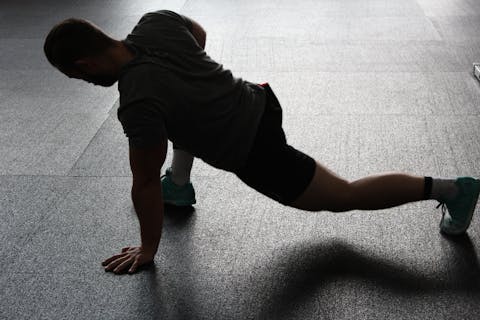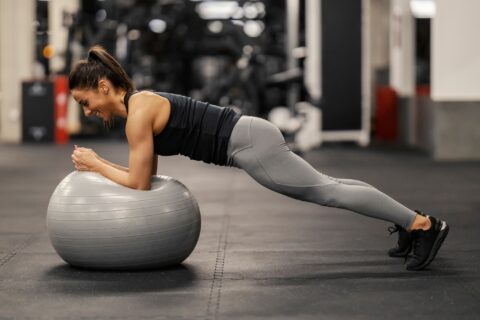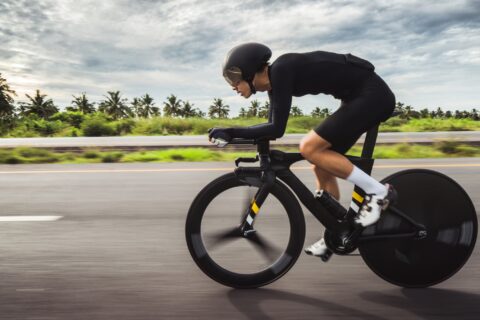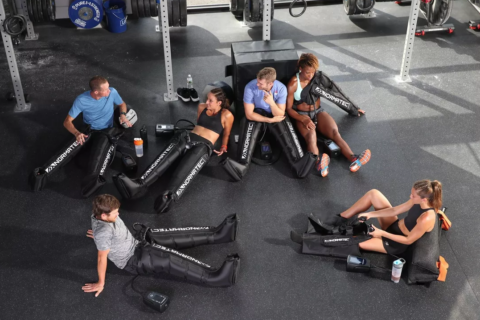Coach Ryan Kohler and Coach Trevor Connor dissect training data to help you understand how to look for signs of freshness before any interval session.
Video Transcript
Chris Case 00:02
Welcome to Fast Talk Laboratories your source for the science of cycling performance.
Introduction
Ryan Kohler 00:09
Hey, it’s Coach Ryan here with Trevor as well and today we’re going to look at how to know when your legs are good in the first few minutes of your ride. We’ll look at two examples. And this first one is the good example. And then we’ll contrast that with, you know, the bad day where you don’t want to probably go and do intervals. Going in here, you’ll see this ride is slated as five by four, VO2 or zone five efforts. So you can see the intervals here later on. But what we’re gonna do is really zoom in here to the early minutes of the ride. And really, it’s about just even within the first 10 minutes, we would know. So let’s zoom in a little bit and what I’m going to do is also zoom in to the map and in this particular place, this is where I kind of know, this stretch of trail is kind of the area to to do this. And it’s relatively flat, and then just a very, very slight uphill. So it’s a nice repeatable place that I know, I can always sort of get to and do the same type of effort to know when I’m good. So you know, if we’re kind of coming along here, and we look at the map, okay, well, now we see this little spike in power. And if we go and look at all the metrics, here, we have power here in the pink, we’ve got speed in green heart rate in red, and then cadence and yellow. And actually, I’m going to get rid of temperature, because we just don’t really need that to tell us if we’re good. This is the the typical approach I’ll take with, with these workouts, as I ride over to the place where I do intervals, is I’m spinning along at a relatively light effort. And then when I get to this location here, we’ll just do a nice acceleration and pick up the power to just a good, hard effort to test the legs, see how they’re doing. And you can see there’s some variation in terrain. But overall, if we just take this effort and look at it, it stands out from the other portions of the ride. So we can say, Alright, well, yeah, that was a good effort, it was definitely up there as it was, it was hard, it should cause a nice sensation in the legs cause some of that heat to build, and we’ll feel some tension. So it gives us a good sensation to sort of think, alright, how do my legs feel and then let me zoom in just a little bit more and if we look at this a little bit closely, here’s the particular area we’re looking at. So coming into this, I’ll be thinking, Hey, how are the legs doing? I really want to test things out and then now okay, let’s hit it. And one, I see this power surge and I say, Okay, well, I know from doing this time and time again, with this acceleration, if I can see that I can quickly hit in the 400-450 range for power. Okay, that’s a good sign. But then the other things I want to look at are well, how does my cadence respond? Because I’m also thinking about the the feeling of the legs, and how quickly can those pedals turn over to make that acceleration?
Ride That’s Going Well
Ryan Kohler 03:06
Next thing I’m looking at is cadence to say, Okay, well, if I made the power, how did the legs feel as I was making that power, so then I look in here, and I’ll say, okay, 90s, low hundreds, and the legs kind of spin up freely and hit the, you know, 113, even on on this effort. And in real time, really looking at this as I’m going along. So it’s just this quick feedback to know, legs are good legs are not so good. So if I see that power hits the targets that I’m used to seeing, with an effort like this, and then I see cadence spins up nice and quickly, the legs are feeling good, excellent. The last thing that I look at is then heart rate. And we know this is a pretty short effort. So it’s going to take a little bit of time for heart rate to start responding. But if I see that, yeah, heart rate was in the 130s, when I did this, and then by the time it’s over, we go up there and bounce into the mid 150s. Personally, I know that, okay, this is a response. That’s typical when I have good interval sessions. So when I see that great, everything looks good. And then I can feel confident about moving into the intervals and having the expectation of a good session. If I saw and this happened many more times to where I’d go and push out a good effort, maybe wouldn’t even hit and we see like 473 here as a peak might not even hit 400. That’s the first sign where something might be a little bit off. Similarly, with cadence spinning along in the 90s. This is one of those things again, over time that you just develop and I know Okay, when I can spin along in the 90s and feel good. That’s a good sign. Now, can I accelerate and go hard? Since this is a zone five workout? Yes. But if we see that we can’t and it just seems hard to spin in the 90s. There’s been other days where I’ve been in like 70s or 80s. And things just feel sort of heavy. That’s a good indicator that Yeah, maybe today’s not the day. Finally, with heart rate. On a day when it’s not working out. I might see that it’s a little bit lower. You know, maybe it’s just it’s failing to rise, and I’m not able to put out the power that’s causing the heart rate response, I would expect. So all of those things are sort of red flags to say, yeah, maybe let’s rethink this. So now let’s take a look at when the legs are bad. And just briefly, if we look at this, this is really six minutes roughly into the workout. So it’s a nice way where you don’t have to get too far into things. Before you know whether or not it’s going to be a good session. So really, I think this is getting to know your body too. So yeah, let’s step into the next one.
Ride That’s Going Not So Well
Ryan Kohler 05:31
Okay, so here’s a ride where things are not going so well. And we were able to tell right from the beginning, I think the comments on here stated that this was just generally a horrible feeling. So, you know, that really ties it up. I think, in the end, where we compare the power, we can see kind of what’s going on there. So I’m going to zoom into the first few minutes here. And a couple of things going on this, this is only the first really four almost five minutes that we’re going to look at. But we’ve got very similar things here. Now this was done indoors, but we still have power, heart rate, cadence, speed, it was indoors, so not worried about that. And we won’t worry about the elevation. But you can see it’s a pretty flat start to the course. So for this one, what we’re looking at is this initial increase in power. And if we just sort of scroll along the side, we can see, you know, 130s 140s 150s, and 110. So you know, low one hundreds in general, maybe mid one hundreds, as we’re starting to spin up, cadence here gets into, you know, mid Upper 80s, and kind of settles in few minutes later, we’re looking at 87. But look at the heart rate too. So if we take that we see it starts off fairly normal gets up here and in the first few minutes, it plateaus in the upper mid 120s. But if we look at that past workout, we know we were hitting 200 300 watts and able to get much better responses from the heart rate. So we look here, even if we take in this section and just average this out, you know, we’ve got 120 watts for power. And heart rate is already what I would consider here relatively sky high. So we have this huge heart rate response. The legs, in addition, we’re just feeling heavy here. So when we see this, where we just we can’t produce that power, and the heart rate is still high, then yeah, that’s a great indicator that the legs might not be that great. And in this one in particular, this was a Saturday. And you know, when I when I felt this happening, I said, Okay, let’s just spin out nice and easy. Make it make sure it’s a really zone one day focus on recovery, came back on Sunday and actually had a great ride. So it’s really making sure we can take these cues early on, you know, get to know our bodies, and kind of put together the understanding we have of like our typical heart rate response, our typical power response, and then that perception of effort to know well, what are those sensations in the legs telling me, put them all together and give us that that opportunity to sort of make a real time decision as to, do we move forward with an interval session or a key session? Or do we just dial this back and say, you know, let’s hit the brakes today and come back tomorrow.
Trevor Connor 08:19
What I really like about this is it’s not just looking at power, you’re using multiple metrics, because I do see athletes will get into this attitude of well, I hit the power, so I must be good today. So let’s just move ahead, and like the do quick effort at 400 watts and go, okay, yep, I’m strong. This is why we have a heart rate monitor and a power meter and look at all these different metrics. So when you’re fatiguing, one of the first places you see it is on the neuromuscular side. So that’s why Ryan was so focused on the the cadence because when you have neuromuscular fatigue, you want to just kind of grind away and hitting those higher cadences is pretty tough. Likewise, the heart rate response, I get asked about this. And this is an important thing to point out. Because we have a time said, If heart rates really high relative to power, you’re fatigued. But if heart rates really low relative to power, you’re fatigued. Which seems like a contradiction. But there’s actually a reason for this. And this is why it’s so important to know what your typical heart rate response is to power. If you have short term damage, let’s say you did some interval work your your muscles are damaged. If you come back the next day and try to do a workout, you have to recruit more muscle fibers to produce the same power. So our heart rate is going to be high relative to power. And that’s what Ryan is seeing here. He has a little bit of muscle damage, but that’s a short term thing and he can probably recover in a day. As he said he came back the next day and rode really well. But that’s why I was seeing an elevated heart rate If heart rate is really sluggish, like you’re putting out the power and go, my heart rate won’t come up and you’re not feeling great. That’s a sign of longer term fatigue. That’s where you’re starting to get into that overreach state. And what’s happening is you’re getting sympathetic fatigue, so your get nervous system fatigue. And that’s an indicator that you probably need several days of rest.
Ryan Kohler 10:25
Yeah, getting a sense for, you know, we have these power meters. And they certainly tell us a lot of information. But yeah, like you said, Trevor, it’s, it’s really about integrating all of the data that we have. And it’s not just about Can I hit this power today, it’s more, you know, in those first couple minutes of a ride, use that data to your advantage. And yeah, get a sense for what your typical response is and then now you can start to make those assessments pretty early on and give yourself more success where you’re not, you know, you’re not going to go and just be a slave to the power meter and say, I have to hit these 250 watt intervals, I’m going to do it come hell or high water, and, you know, whatever the heart response is, we don’t really care. So yeah, really, it’s about integrating those, I think throughout your entire ride. So yeah, great feedback. So if you have any files or additional questions on this or want to, you know, post some things and discuss more, come on over to forums.fasttalklabs.com and submit your questions. We’d love to see them.





